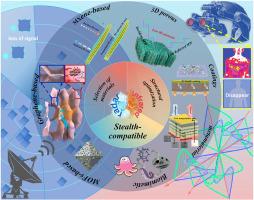Radar-infrared compatible stealth technology in advanced nano-composite materials: Mechanisms and structural optimization
IF 8.2
2区 材料科学
Q1 MATERIALS SCIENCE, MULTIDISCIPLINARY
引用次数: 0
Abstract
Nowadays, multifunctional detection systems and reverse detection technologies play a dominant role in military reconnaissance and stealth gaming operations. Therefore, stealth technology, as the most powerful means of reverse detection, has increasingly become a research hot spot. In particular, when the detection weapons are equipped with radar and infrared detection, how to achieve effective compatibility of stealth to minimize the loss and the success of military operations is still a major challenge in current research. Therefore, this review provides an indepth discussion and distinction between the mechanisms of radar and infrared detection technologies, respectively, while emphasizing the technical challenges involved in achieving compatible stealth. Besides, the review explores the microwave absorption and infrared stealth properties of innovative advanced nano-composites materials (MXene, graphene, and metal-organic frameworks (MOFs)) reported to date. Subsequently, the review analyzes the properties, structural design, and optimization strategies of recently reported compatible stealth materials, ranging from low-dimensional to high-dimensional structures, and discusses in detail the recent advances in compatible stealth materials. Finally, the review summarizes the advantages of developing various materials and structures in this promising field, providing a comprehensive overview of their potential and efficacy.

先进纳米复合材料中的雷达-红外线兼容隐身技术:机理和结构优化
如今,多功能探测系统和反向探测技术在军事侦察和隐形博弈行动中发挥着主导作用。因此,隐身技术作为反向探测的最有力手段,日益成为研究热点。特别是在探测武器配备雷达和红外探测时,如何实现隐身的有效兼容,最大限度地降低军事行动的损失和成功率,仍是当前研究的一大难题。因此,本综述分别对雷达和红外探测技术的机理进行了深入探讨和区分,同时强调了实现兼容隐身所涉及的技术挑战。此外,综述还探讨了迄今报道的创新先进纳米复合材料(MXene、石墨烯和金属有机框架(MOFs))的微波吸收和红外隐身特性。随后,综述分析了近期报道的兼容隐身材料(从低维结构到高维结构)的特性、结构设计和优化策略,并详细讨论了兼容隐身材料的最新进展。最后,综述总结了在这一前景广阔的领域开发各种材料和结构的优势,全面概述了它们的潜力和功效。
本文章由计算机程序翻译,如有差异,请以英文原文为准。
求助全文
约1分钟内获得全文
求助全文
来源期刊

Materials Today Nano
Multiple-
CiteScore
11.30
自引率
3.90%
发文量
130
审稿时长
31 days
期刊介绍:
Materials Today Nano is a multidisciplinary journal dedicated to nanoscience and nanotechnology. The journal aims to showcase the latest advances in nanoscience and provide a platform for discussing new concepts and applications. With rigorous peer review, rapid decisions, and high visibility, Materials Today Nano offers authors the opportunity to publish comprehensive articles, short communications, and reviews on a wide range of topics in nanoscience. The editors welcome comprehensive articles, short communications and reviews on topics including but not limited to:
Nanoscale synthesis and assembly
Nanoscale characterization
Nanoscale fabrication
Nanoelectronics and molecular electronics
Nanomedicine
Nanomechanics
Nanosensors
Nanophotonics
Nanocomposites
 求助内容:
求助内容: 应助结果提醒方式:
应助结果提醒方式:


